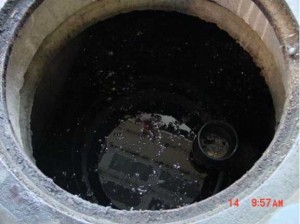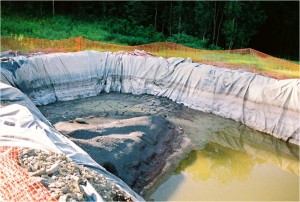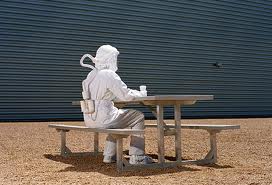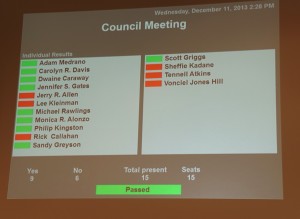Natural Gas
Why Downwinders is involved in the Azle Earthquake Fight
 Downwinders at Risk's Jim Schermbeck was one of several speakers at the public organizing meeting on January 13th in Azle, just northwest of Ft. Worth, that saw the creation of a local citizens group to campaign to end the "human-induced" earthquakes plaguing the area for the past several months.
Downwinders at Risk's Jim Schermbeck was one of several speakers at the public organizing meeting on January 13th in Azle, just northwest of Ft. Worth, that saw the creation of a local citizens group to campaign to end the "human-induced" earthquakes plaguing the area for the past several months.
On Tuesday, he'll climb aboard a bus with Azle area residents and go to Austin to speak before the Texas Railroad Commission about the need to cease operations at local fracking waste injection wells until a Unites States Geological Service study on problem in completed in April.
Why is a group whose stated mission is protecting the DFW airshed getting involved with a fight over injections wells and earthquakes?
1. We were asked to. There just aren't that many groups in Texas that employ someone who knows how to parachute into a community and start an effective campaign from scratch. Downwinders is one of them. When we're asked to help a community we haven't been involved in before, as we were in Frisco, and as we are now in Azle, we think about our own past and the lack of any professional resources on the scene in the early 1990's during our fight with the Midlothian cement kilns. If we can be of some help in assisting people who legitimately need it, we usually don't turn them down.
2. Injections wells can be significant sources of air pollution. These facilities can dispose of 100 to 200 million gallons or more of waste every year. Besides fugitive emissions for unloading and storage, some injection wells also have outdoor pools of waste that systematically evaporate pollutants into the air. Injection wells are known to contribute to air quality problems on the ground similar to those experienced by original Downwinders living near the Midlothian cement kilns when they were burning hazardous waste. It turns out there are downwinders surrounding injection wells too. These well emissions are not only a toxic threat to residents living in the immediate vicinity, but they also contribute to regional smog problems too.
3. A win in Azle could led to saner restrictions on locating injection wells. It looks like the recent "swarm" of earthquakes around Azle are centered between two active injection wells. Why are these wells causing problems but others aren't? And why are injection wells being placed in densely populated areas near lots of water wells and infrastructure? DFW Airport saw earthquakes from their injection well and it got closed. Azle residents just want the same respect as American Airlines jets. Are there places in Texas where injections wells shouldn't be located? Yes. Like airports and places where people live near-by. Is it possible to use the Azle fight to better articulate that, regionally or even statewide? Yes. And that would be a good thing.
4. Azle represents an opportunity to organize and win deep behind enemy lines. Azle is in the heart of the Barnett Shale. It's already surrounded by wells and pipelines and compressors, and yet area residents know the shaking that's disrupting their lives is directly linked to fracking itself. This is a revolt of the already-gassed masses, something the western part of the Metromess hasn't seen. It's also true that Azle is prime tea-party GOP territory. Making alliances there helps give lie to the myth that environmental health is only something Democrats and tree-huggers are concerned about. Azle residents can't be easily dismissed as Greenpeace types. You can already see the worry from elected officials over the rise of these new critics. Railroad Commission special meetings. The hiring of a new state seismologist. A new legislative committee on quakes. All in less than a month. This ain't Austin. It's not even Dallas.
That's why we're getting on the bus come Tuesday.
It Happened Last Night
 Azle area families are proud to announce the birth of their new grassroots group, and movement, born last night around 8:30 pm, CST.
Azle area families are proud to announce the birth of their new grassroots group, and movement, born last night around 8:30 pm, CST.
It's so new, the 300 or so parents haven't had a chance to name it yet. But it does have a mission: challenging the Barnett Shale status quo.
There's an air of mystery surrounding how these things happen. Many people don't want to be in the room when it actually occurs. Many get nervous. Sometimes it gets messy.
But it's really quite a simple procedure and last night the delivery room was primed for quick and decisive action by two earthquakes in the last 24 hours. No prolonged labor this time. When the call went out to fill the ranks of a local steering committee, bodies shot up out of chairs and spoke their names into the mic for posterity. Male and female, booted and sneakered, grandparents and their grandchildren, Black, Anglo and Hispanic. At the end, approximately 20 volunteers stood in front of the crowd receiving a thankful ovation from their peers.
There are few more poignant moments you can witness in American democracy than the birth of real citizenship.
The newcomer will be taking its first baby steps very soon – at least one bus is being chartered to go to the next Railroad Commission meeting in Austin this next Tuesday, January 21st, and speak to the need of immediate help versus the delay and more study approach of the state. The meeting begins at 9:30am. Details are being worked out now, but the parents say you don't have to be from the Azle area to join the Austin protest. It takes a region to raise a ruckus.
Congratulations to the parents. May their offspring grow up to be strong and smart, and know how to do its job in the shortest amount of time possible. Here's some sample news coverage of the birth:
“We don’t really know, 8,000 feet below, where the waste goes”
 That's Texas Supreme Court Justice Paul Green blurting out an unfortunate truth even as he was trying to defend an injection well that's being sued for trespassing into groundwater under an adjacent rice farm in Liberty County near the Texas gulf coast.
That's Texas Supreme Court Justice Paul Green blurting out an unfortunate truth even as he was trying to defend an injection well that's being sued for trespassing into groundwater under an adjacent rice farm in Liberty County near the Texas gulf coast.
The Texas Tribune's Jim Malewitz has the scoop on a so far mostly over-loooked case that could set some important precedents about land rights and underground contamination. How do we know? Because the oil and gas industry told Maelwitz:
In 1997, Environmental Processing Services finished drilling an injection well about 400 feet from FPL Farming’s land, which the farm contested early on. Since then, the company has injected more than 100 million gallons of wastewater, gradually expanding the well's underground footprint.
The well in question is labeled Class I and used for nonhazardous industrial waste. It is not one of the 50,000 Class II wells that drillers typically use. But lower-court opinions have drawn no distinction between the wells. That has stirred concerns among oil and gas producers that a ruling in the farm’s favor would complicate efforts to dispose of drilling waste, thereby stalling production.
“Because the ability to produce oil and gas is inextricably tied to the availability of injection wells,” the Texas Oil and Gas Association says in a brief, “a new common law cause of action that threatens operation of injection wells likely threatens oil and gas production."
As Malewitz points out, the case raises the questions of "just how far below the earth’s surface do property lines extend? And can someone trespass on another’s property — more than a mile underground?"
Since it's close to the coast, the farm's groundwater is too salty to drink now but the farm's lawyers argue that desalinization technology could render the water useful. They say regardless of its salinity, it's a resource and a piece of private property that's being poisoned by the well's waste stream that includes the flammable liquid acetone.
Now you may think the waste well operators, "Environmental Processing Services," would deny any contamination of the farm's water as a first line of defense. But as it turns out everyone in industry and the regulatory agencies believes that after you've pumped 100 million gallons of industrial waste down a hole 800 feet deep, it will tend to "migrate" outside the fence line of the well itself. So what kind of arguments are EPS's lawyers that the Texas Supreme Court is finding so persuasive?
1) Our waste may be migrating, but since we can't go down there and check, you really can't conclusively prove that it's under the farm…yet. All you have is an industry-government model that everybody uses that says it has.
2) The water is already polluted with too much salt, so there's no way you can pollute already polluted water. So there.
3) Even if it is polluted by our waste, maybe that same desalinization technology the farm wants to use to make the water useable will also be able to filter our industrial waste out if it.
Of course, these equivocating arguments in court by lawyers are a far, far cry from the air-tight assurances Texans get from the industry spokespeople or slavishly pro-industry elected officials, who GUAR-AN-TEE that no fracking waste injection well could ever contaminate groundwater.
Really. You should go read the article. The lawyers are making lots of money on this one. No timeline for a ruling.
Was Azle the Barnett Shale’s “Walter Cronkite Moment?”
 When Walter Cronkite announced that America was losing the war in Vietnam, LBJ knew he'd lost Middle-America.
When Walter Cronkite announced that America was losing the war in Vietnam, LBJ knew he'd lost Middle-America.
When the gas industry is losing the editorial board of the Fort Worth Star-Telegram, is it a sign it's losing the PR war in the Barnett Shale?
While Sunday's editorial in the Star-Telegram, titled "Texas Railroad Commission can’t just tippy-toe around quakes" falls far short of a wholesale condemnation of urban injection well operations, it does castigate the Railroad Commission for being promoters of fracking while also being assigned to regulate it on behalf of the public good, and faults it for failing to provide any new facts to the debate at its disastrous public meeting last week in Azle.
Is the three-member commission doing anything to separate facts from speculation and theories?
“In addition to taking the residents’ comments into serious consideration, Commissioner Porter has been in communication with the state geologist in regards to a potential study by the Bureau of Economic Geology,” Porter’s news release said. “Railroad Commission staff is also participating in a work group formed by the Environmental Protection Agency, which includes representatives from the United States Geological Survey and other state regulatory agencies.”
There’s “serious consideration,” a “potential study” and a “work group.” Sounds like tippy-toeing.
In fact, there is a considerable amount of science linking disposal wells, which push millions of gallons of drilling waste into rock formations deep under ground, with “induced” earthquakes.
A report posted in July described one study by USGS scientists. The results were also published in the journal Science.
The rate of quakes increased to about 100 a year in the central and eastern U.S. in the three-year period from 2010 through 2012, up from an average 21 a year from 1967-2000, the study showed. The increase coincided with a rapid increase in oil and gas drilling using hydraulic fracturing, which leaves large amounts of waste water for disposal.
In many ways, the developments in Azle last week represent a bigger threat to the industry than residents' December victory in Dallas over a more protective gas drilling ordinance. It's deep in the heart of the urban Shale instead of being at its edge. It's a spontaneous grassroots revolt led by people who probably voted for Ted Cruz instead of Paul Sadler in 2012. Its participants have lived with fracking for almost a decade now instead of fighting off an invasion as in Dallas. These are folks who are more likely to carrying a concealed weapon than a Sierra Club membership.
It's also true that both industry and government have been caught off-guard by the issue of injection-well earthquakes and are unable to bat down the arguments the way they can with harms that take more time, and have more subtle causal links, like cancer. Empirical evidence makes the case pretty plain, as the Star-Telegram editorial admits. Denials by industry in the midst of earthquake "swarms" centered on injection well locations seem like the environmental equivalent of a reassuring "Baghdad Bob" show while the bombs are falling in the background.
Do the circumstances taking place in the western part of the Metromess represent a new front on the fracking fight in North Texas, or just a momentary rise in tensions that will be gone by the Spring? A lot depends on whether the pace of earthquakes that gave rise to the Azle meeting keep occurring. Thirty of them have been recorded since November alone and if they keep showing up at that rate, there'll be little need of community organizing meetings to get people motivated to do something. The question is what that something is.
A prohibition on injection wells within Standard Metropolitan Areas? Within certain population densities? Within proximity of water wells and infrastructure? A moratorium on any new wells anywhere? Is there and answer that can help the people in Azle and maybe others in the Shale at the same time?
Time will tell whether last week's meeting is a real turning point for facts on the ground, but it's already clear that it marked a milestone in terms of perception. And as we're often fond of saying here at Downwinders, perception is everything.
Follow-Up Study Confirms Lower Birth Weight Babies Around Fracking Sites
 A 2012 study by a Cornell graduate student Elaine Hill that found a 25% increase in low-birth weight babies within 1.5 miles (7920 feet) of a gas fracking sites in Pennsylvania got a boost from a follow-up study previewed over this last weekend at a conference in Philadelphia.
A 2012 study by a Cornell graduate student Elaine Hill that found a 25% increase in low-birth weight babies within 1.5 miles (7920 feet) of a gas fracking sites in Pennsylvania got a boost from a follow-up study previewed over this last weekend at a conference in Philadelphia.
Janet Currie of Princeton University, Katherine Meckel of Columbia University, and John Deutch and Michael Greenstone of the Massachusetts Institute of Technology also looked at Pennsylvania birth records and found the risk of low-weight births increased by 50% within 2. 5 kilometers (8125 feet) of a fracking site. That's over 7 times the distance of the recent 1500 foot buffer zone between homes and drilling pads passed by the City of Dallas last month.
This rate was constant for both households with their own water wells and municipal water system users, seemingly ruling out water contamination as a cause. Air, noise and light pollution are now the suspected culprits.
This second study was specifically designed to address critics of Hill's previous work:
"….they built on the work of Elaine Hill, a PhD student at Cornell University who sparked controversy in 2012 with a study showing that infants born near fracked gas wells had more health problems than infants born near sites that had merely been permitted for fracking. One criticism of Hill's study was that fracking activity might change the demography of an area, attracting more mothers who are likely to give birth to infants with health problem.
The new research addresses such concerns by following a constant group of mothers who had children both before and after the onset of fracking, and by controlling for geographical differences in mothers' initial health characteristics. It seeks to achieve the rigor of a controlled experiment by focusing on mothers who, due to their locations and the dates of their pregnancies, were effectively selected at random to be exposed to fracking.
The study is expected to be accepted for publication sometime this Spring after being peer-reviewed.
Merry Xmas and Have a Less Poisonous New Year
Coming to A Cement Plant Near You? Burning Fracking Fluid
 A Canadian LaFarge Cement plant wants to start using fracking fluid to replace fresh water it uses in its manufacturing process.
A Canadian LaFarge Cement plant wants to start using fracking fluid to replace fresh water it uses in its manufacturing process.
The company's Brookfield plant in Nova Scotia is an ancient "wet kiln" that uses approximately 35 million liters of water from a near-by lake to produce cement. Fracking fluid that has been run through a reverse osmosis filtering process would be used as a parital substitute for this fresh water.
According to the local newspaper account, a LaFarge PR spokesman is quoted as saying “It’s safe enough to drink. The contaminants have been removed and the recycled waste water exceeds government guidelines to be released in the environment.”
But funny thing. Despute that assurance of safety, when the company ran a full page ad announcing its plans to use waste water, it forgot to mention that it was waste fracking fluid. Maybe because there's a moratorium on fracking in the Province while a review of its safety and public health impacts are investigated.
Local municipal Council Member Doug MacInnes said he spoke to the LaFarge plant manager about the ad.“He explained to me that it was worded that way so that it wouldn’t get the public upset." According to the LaFarge manager, "I think there is a negative connotation with fracking."
So where is the waste fracking fluid coming from? From two local holding ponds that have been containing the leftovers of three wells way back in 2007 and 2008. About 14 million litres of fresh water was used. When this water was regurgitated by the wells it was poured into the ponds. Many observers believe that although this first step is only a pilot test, LaFarge wants to begin importing fracking fluid from Canada's large oil and gas plays.
When it was burning hazardous wastes in its own wet kilns in Midlothian from 1986 to 2008, TXI Cement also charged companies for disposing of their industrial waste waters, which often contained Volatile Organic Compounds (VOCs), heavy metals, chlorine and other contaminants. Back then, it was called "recycling" and was defended by TXI as a way to reduce fresh water use, and costs. TXI used the "Long, Hot and Good For America" argument it always used to defend the burning of waste – that the high temperatures of the kiln destroy all the bad stuff. Only that's not true. Metals don't burn. Chlorine doesn't burn. And Dioxin can actually be created when plastics are burned.
And there was another problem unique to the disposal of wastewater. The contaminants, especially the VOCs, were being lost to the atmosphere long before the water reached the plant's kilns with their 2500 degree temperatures – the rising heat stripped the pollutants out of the water and sent them up the stacks, causing an increase in pollution. For these reasons, EPA forced TXI to quit using industrial wastewater as a substitute for fresh water even before the wet kilns shut down permanently in 2008 and waste-burning was halted.
With fracking waste water, you get all these kinds of pollutants plus the added threat of radioactivity, of which there is no mention in any of the coverage about the LaFarge proposal. "Natural radioactive elements" as well as ones used in the drilling process have been known to contaminate fracking waste. Reverse osmosis won't be able to fix that.
We've written about idea of oil and gas fracking fluid flowing downhill to the cement plant industry – the least regulated option – for disposal, most recently when it came up in Saudi Arabia. Now it's jumped the pond and has landed in North America. How long do you think it'll be before you see a cement plant near or in a US shale play that will propose the same thing?
One of the practical concerns of citizens over the plans of the LaFarge plant is the effect corrosive fracking fluid that's full of salt has on an industrial process dependent until now on fresh water.
The local Colchester County Council. is planning to send a letter of concern to Lafarge, the minister of Environment, and the local Department of Environment office. Last summer, council rewrote its sewage use bylaw and rejected an application by a local firm to dispose of treated frack waste through the municipal sewer system because of potential dangers to the environment. That same firm is the one that says it will filter the fracking fluid before sending it to LaFarge.
Dallas Council Passes 1500 Foot Setback and Rest of Draft Ordinance
 It was rumored to be a done deal as of last week. Today it actually is.
It was rumored to be a done deal as of last week. Today it actually is.
By a vote of 9 to 6, the Dallas City Council voted to endorse the new gas ordinance drafted by its City Plan Commission, including its 1500-foot setback requirement for wells and compressor stations.
The only change to the Commission recommendations came in a procedural tweak that now requires six votes to stop a variance being rolled back to a minimum of 1000 feet instead of four.
Oak Cliff Council Member Scott Griggs made the motion to approve the Plan Commission recommendations. Before his motion could be voted on however, East Dallas Council Member Sheffie Kadane made a substitute motion to reduce the required setback to 500 feet. This was the stark choice that faced the Council.
They chose wisely. 1500 feet matches the most protective buffer zone current restrictions in the Barnett Shale. It's more than twice as far as the 600 foot setback on the books in Fort Worth. Even the new Dallas minimum of 1000 feet is 400 more than Forth Worth's maximum. Much of todays' public hearing testimony touched on health effects felt by Shale residents who had lived from 300 to 1200 feet from wells.
Along with the defeat of the Trinity East permits earlier in the year, passage of the Dallas ordinance represents the biggest recent victories of urban fracking opponents in the Barnett Shale.
Not only is there a brand new "Dallas Model" to compete and contrast with the "Fort Worth Model" that industry loves to tout, but there's a brand new feeling that environmentalists actually have some clout in city politics in Dallas for the first time.
Congratulations to all those who worked so hard to see this result happen against so many obstacles over the last four years. Well done.
Beginning at 1pm Today, Walk the Last 1500 Feet With Us
 It's been four years since the first Dallas City Plan Commission meetings on pending gas permits. It's been three years since the Dallas Gas Drilling Task Force was formed. It's been 12 months since Mayor Rawlings' announced he was fast tracking the Trinity East gas permits. It's been 10 months since the Dallas Observer published former City Manager's embarrassing secret deal over park land drilling between herself and Trinity East. It's been seven months since Suhm announced her retirement. It's been four months since the Trinity East permits went down in defeat. It's been three months since the Plan Commission passed its draft of the new Dallas Gas Ordinance, including a provision for a 1500-foot setback. What a long, strange trip.
It's been four years since the first Dallas City Plan Commission meetings on pending gas permits. It's been three years since the Dallas Gas Drilling Task Force was formed. It's been 12 months since Mayor Rawlings' announced he was fast tracking the Trinity East gas permits. It's been 10 months since the Dallas Observer published former City Manager's embarrassing secret deal over park land drilling between herself and Trinity East. It's been seven months since Suhm announced her retirement. It's been four months since the Trinity East permits went down in defeat. It's been three months since the Plan Commission passed its draft of the new Dallas Gas Ordinance, including a provision for a 1500-foot setback. What a long, strange trip.
Today, we're down to the final public hearing and the final council vote on that new ordinance. The only mystery left is whether that 1500-foot setback will remain in place or be whittled back to allow drilling as close as 500 feet to homes. It's the difference between matching the most protective buffer zone in the region, or following the lead of the most permissive cities in the Shale like Fort Worth.
We're poised to win one of the biggest victories against the gas lobby in North Texas since urban drilling began in 2006. We're on the verge of creating a new model for cities, one that better incorporates the newest science and technology. All it takes is one more push, one more vote.
Many of you have been with us every step since 2011. Many others have fallen in along the way. We're asking all of you to walk that final 1500 feet with us today. Come down to City Hall at 1 and participate in the news conference in the Flag Room on the 6th floor just outside the Council Chambers. Speak for the allotted three minutes at the public hearing on the gas ordinance that will follow, witness history, and then come to what we hope will be a victory celebration at Lee Harvey's afterwards.
Don't let the last four years be in vain. Come on down to City Hall and help us finish the job. Thanks.
Better Living Avoiding This Chemistry: An Industrial Toxic Primer
 Even though this EcoNews article is about air poisons that result from fossil fuel production, it applies to just about any combustion source, including cement plants, manufacturing plants, vehicles, and so on. It's a pretty good top ten list, although you wonder why Dioxins and Furans got left off, since they're toxic by the gram instead of pound. Also missing is Particulate Matter as a stand alone threat, although it gets a shout out as a by-product. Nevertheless, these are the among the most dangerous pollutants that have caused and are still causing a lot of problems in North Texas and elsewhere:
Even though this EcoNews article is about air poisons that result from fossil fuel production, it applies to just about any combustion source, including cement plants, manufacturing plants, vehicles, and so on. It's a pretty good top ten list, although you wonder why Dioxins and Furans got left off, since they're toxic by the gram instead of pound. Also missing is Particulate Matter as a stand alone threat, although it gets a shout out as a by-product. Nevertheless, these are the among the most dangerous pollutants that have caused and are still causing a lot of problems in North Texas and elsewhere:
1. Benzene
Benzene is a well-established carcinogen with specific links to leukemia as well as breast and urinary tract cancers. Exposure to benzene reduces red and white blood cell production in bone marrow; decreases auto-immune cell function (T-cell and B-cells); and has been linked to sperm-head abnormalities and generalized chromosome aberrations.
Benzene is one of the largest-volume petrochemical solvents used in the fossil fuel industry. It is a major component in all major fossil fuel production: oil, coal and gas. People are exposed to it from inhaling automobile exhaust and gasoline fumes, industrial burning such as oil and coal combustion, and exposure to fracking fluids.
There's a recent Emory University study concluding that risk for leukemia fell with every mile between a person's home and facilities that release benzene.
2. & 3. Sulfur Dioxide (SO2) and Nitrogen Oxides (NOx)
Sulfur dioxide (SO2) and nitrogen oxides (NOx) are two primary examples of particle-forming air pollutants (particulate matter). Particulate matter is known to contribute to serious health problems, including lung cancer and other cardiopulmonary mortality. SO2 and NOx are both highly toxic to human health, and contribute directly to thousands of hospitalizations, heart attacks and deaths annually.
SO2 is particularly dangerous for children. Studies correlate SO2 emissions from petroleum refineries—even in lower exposure levels over time —to higher rates of childhood asthma in children who live or attend school in proximity to those refineries. Similarly, small particles of NOx can penetrate deeply into sensitive lung tissue and damage it, causing premature death in extreme cases. Inhalation of such particles is associated with emphysema and bronchitis.
4. Petroleum Coke (Pet Coke)
Pet coke is a by-product of oil processing that's also used as a fuel. It's a heavy dust which resembles coal. It's burned in power plants and cement plants. It contains dozens of dangerous chemicals and heavy metals, including chromium, vanadium, sulfur and selenium. It's a huge contributor to particulate mater and NOx and SOx formation
5. Formaldehyde
Formaldehyde is a carcinogen with known links to leukemia and rare nasopharyngeall cancers, according to the International Agency for Research on Cancer. Formaldehyde is highly toxic regardless of method of intake. It is a potent allergen and genotoxin. Studies have linked spontaneous abortions, congenital malformations, low birth weights, infertility and endometriosis to formaldehyde exposure. Epidemiological studies link exposure to formaldehyde to DNA alteration. It is also contributes to ground-level ozone.
Independent studies, have detected dangerous levels of formaldehyde in both wastewater and ambient air emissions from fracking operations. One researcher, with the Houston Advanced Research Center, said reading from one test site in North Texas, “astoundingly high,” and, “I’ve never heard of ambient (formaldehyde) concentrations that high… except in Brazil.”
6. Polycyclic Aromatic Hydrocarbons (PAHs)
In actuality, this is not a single listing—polycyclic aromatic hydrocarbons (PAH) is an entire class of toxic chemicals, linked together by their unique chemical structure and reactive properties.
Many PAHs are known human carcinogens and genetic mutagens. In addition, there are particular prenatal health risks: prenatal exposure to PAHs is linked to childhood asthma, low birth weight, adverse birth outcomes including heart malformations and DNA damage.
Additionally, recent studies link exposure to childhood behavior disorders; researchers from Columbia University, in a 2012 Columbia University study, found a strong link between prenatal PAH exposure and early childhood depression. Infants found to have elevated PAH levels in their umbilical cord blood were 46% more likely to eventually score highly on the anxiety/depression scale than those with low PAH levels in cord blood. The study was published in the journal Environmental Health Perspectives.
7. Mercury
Mercury is a dangerous neurotoxin emitted from coal-fired power plants and any other combustion source using coal for fuel – like the Midlothian cement plants. It damages the brain and the nervous system either through inhalation, ingestion or contact with the skin. It is particularly dangerous to pregnant women and children. It is known to disrupt the development of the in-vitro brain. In low doses, mercury may affect a child’s development, delaying walking and talking, shortening attention span, and causing learning disabilities. High dose prenatal and infant exposures to mercury can cause mental retardation, cerebral palsy, deafness and blindness. In adults, mercury poisoning can adversely affect fertility and blood pressure regulation and can cause memory loss, tremors, vision loss and numbness of the fingers and toes.
One out of every six women of childbearing age in the U.S. have blood mercury levels that could be harmful to a fetus, according to EPA reports. The EPA estimates that 300,000 children are born each year at risk for significant development disorders due to mercury exposure.
8. Silica (Silicon Dust/Sand)
Crystalline silica (“frac sand”) is a known human carcinogen; breathing silica dust can lead to silicosis, a form of lung disease with no cure. This is a hazard in the cement industry and threat to those living downwind of cement plants, and now it appears to be one for natural gas roughnecks and adjacent homeowners as well.
Silica is commonly used, in huge amounts, during fracking operations. Each stage of the process requires hundreds of thousands of pounds of silica quartz–containing sand. Millions of pounds may be used for a single well.
The presence of silica in fracking operations, simply put, is a major safety risk with a high likelihood of dangerous exposure. Case in point: researchers from the National Institutes of Occupational Safety and Health (NIOSH) recently collected air samples at 11 fracking sites in five different “fracking states” (CO, ND, PA, TX and AR) to evaluate worker exposure to silica. Every single site had measures higher than the NIOSH threshold for safe exposure—so high, in fact, that about one-third of the samples collected were even above the safe threshold for wearing a safety respirator mask. This was reported in May 2013 in the Journal of Occupational and Environmental Hygiene.
9. Radon
Radon is a colorless, odorless, tasteless radioactive gas which causes lung cancer. It is the second largest cause of lung cancer in the U.S. after cigarette smoking. About 20,000 people per year die from lung cancer attributed to radon exposure according to the National Cancer Institute. Further, there is no known threshold below which radon exposures carries no risk.
Radon exposure can come from a variety of natural sources. However, fracking (natural gas) represents a significant new and increased source of radon exposure to millions of citizens. Radon is released into local groundwater and air during fracking operations. It also travels through pipelines to the point of use—be it a power plant or a home kitchen.
The science behind radon release and exposure is complex but explained well here by Christopher Busby, the Scientific Secretary of the European Committee on Radiation Risk, who warns that radon dangers from fracking “have not been addressed properly (or at all) by the environmental impact statements published by the operators, or by the Environmental Protection Agency in the USA.”
10. Hydrofluoric Acid (HF) / Hydrogen Fluoride
Hydrofluoric acid (HF) is “one of the most dangerous acids known.” HF can immediately damage lungs, leading to chronic lung disease; contact on skin penetrates to deep tissue, including bone, where it alters cellular structure. HF can be fatal if inhaled, swallowed, or absorbed through skin.
The senior laboratory safety coordinator at the University of Tennessee said, “Hydrofluoric Acid is an acid like no other. It is so potent that contact with it may not even be noticed until long after serious damage has been done.”
Hydrofluoric Acid is a common ingredient used in oil and gas extraction.
Numerous studies, including recent ones conducted by both The Center for Public Integrity (CPI) and the United Steelworkers Union (USU) cite the oil industry’s abysmal safety record as a high risk factor for a major HF accident; over the past decade, more than 7,600 accidental chemical releases from refineries have been reported by the industry. In the past three years alone, a total of 131 “minor” accidents involved HF.

